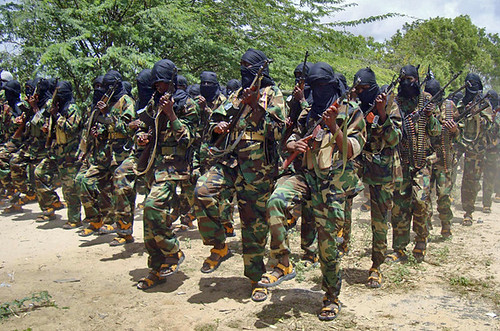
Somalia resistance forces in formation. The U.S.-backed Transitional Federal Government has suffered another blow in the aftermath of the resignation of the Prime Minister with the withdrawl of support by a pro-TFG militia group on September 25, 2010., a photo by Pan-African News Wire File Photos on Flickr.
Kenya’s Somali mission causes a devastating blowback at home
geoffrey york
JOHANNESBURG— From Friday's Globe and Mail
For 20 years, Somalia has been a deadly quagmire for foreign troops: American, Ethiopian, even Canadian. Now another country, Kenya, is learning the risks of sending soldiers into one of the world’s most dangerous and war-torn states.
Less than two weeks after ordering hundreds of its troops across the Somali border in a bold military offensive, Kenya is already seeing a rising toll in collateral damage. Three grenade attacks inside Kenya, including one on Thursday, have killed five civilians and injured scores more in suspected retaliatory attacks by Somali militants and their allies.
The grenade attacks will inflict severe damage on Kenya’s tourism industry, a key sector of the economy. Foreign embassies have issued warnings to travellers to stay away from the East African country, and hotels in Nairobi are already seeing cancellations. The kidnapping of four Western aid workers and tourists by Somali gunmen in Kenya has further damaged the tourism industry.
The Kenyan invasion is also hampering refugee movements and aid deliveries by the international famine relief effort, which is trying to prevent a humanitarian catastrophe in southern and central Somalia, where up to 80,000 people have already died. The number of Somali refugees reaching Kenya has plunged dramatically, from an average of about 1,000 daily last month to just 100 a day this week.
“Escalating fighting across the south of Somalia is making it even more difficult for our partners to safely deliver life-saving support to children and their families,” said Elhadj As Sy, a senior official of Unicef, the United Nations fund for children.
As for the military offensive itself, it has become bogged down in heavy rains and mud in southern Somalia, with few gains except empty desert so far. Despite logistical support from France and its own tanks and warplanes, Kenya’s troops have still not captured their first key target, the strategic town of Afmadow, 100 kilometres from the Kenyan border, where the Somali militant group al-Shabab is preparing its defences.
The Kenyan forces clashed with al-Shabab fighters on Thursday for the first time. Kenya said it killed nine al-Shabab insurgents and suffered two injuries on its own side.
“The history of recent foreign military interventions in Somalia is universally bad,” said Roger Middleton, an Africa analyst at the Chatham House think tank in London. “Foreign troops entering Somalia have often left behind a situation that is worse than the one they sought to improve.”
The United States withdrew its forces from Somalia in 1994 after the notorious Black Hawk Down battle, where 18 of its soldiers were killed in the bloodiest U.S. combat loss since Vietnam. Canada pulled its troops out of Somalia after revelations that some of its soldiers had participated in the torture and beating death of a Somali civilian.
In 2006, Ethiopia sent thousands of its troops into Somalia, but failed to pacify the country. Instead the invasion strengthened the influence of the Islamist radicals of al-Shabab, who gained control of southern Somalia and Mogadishu after the Ethiopians pulled out.
The Islamist militants, who have links to al-Qaeda, had vowed to take revenge in Kenya after Kenya launched its invasion. Last week, the U.S. government warned of “an imminent threat of terrorist attacks” at malls and nightclubs in Kenya. And then the grenade attacks began.
On Monday, one person was killed and scores were injured in two grenade attacks at a bus stop and a bar in Nairobi. Two days later, a Kenyan man pleaded guilty to one of the attacks and identified himself as a member of al-Shabab. The attacks show how the Somalia conflict is spilling across borders and mutating into hit-and-run terrorist tactics.
On Thursday, in the latest attack, heavily armed gunmen in northern Kenya ambushed a civilian vehicle with rocket-propelled grenades and machine guns, killing four people, including a school teacher and a government official. Al-Shabab militants were again the suspected culprits.
One of al-Shabab’s senior leaders, Sheik Muktar Robow, said on Thursday that he is telling militants in Kenya to launch bombing attacks. “A hand grenade is nothing,” he told hundreds of Shabab supporters in a rally near Mogadishu. “We want you to carry out big painful blows to Kenya.”
Last week, al-Shabab publicly displayed the bodies of dozens of soldiers that it claimed to have killed in Mogadishu, including many Burundians from an African Union peacekeeping mission. In an attempt to portray the conflict as a religious war, they displayed Bibles and crucifixes from the Burundian soldiers.
No comments:
Post a Comment